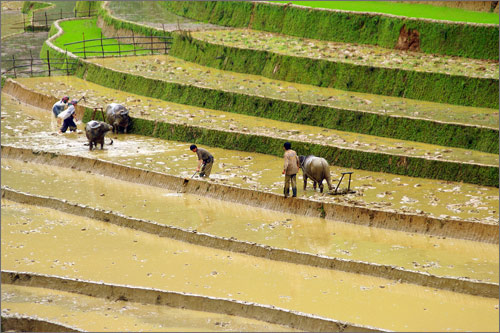Located in the coastal district of Vinh Linh in the central province of Quang Tri , Cua Tung Beach is the nation's "Queen of Beaches", awaking the curiosity of many visitors to come and experience its beauty.
 |
| Cua Tung Beach |
The kilometre-long beach is neither long nor wide, but the water is gentle and clear. Two underground rock formation, Mui Si and Mui Lai, encroach on the sea, creating a small bay sheltering the beach from stronger waves and tides.
The beach is surrounded by a belt of basalt and stone mountains that look like a huge comb passing through the hair of the waves. On the hill, orchards of jackfruit, pineapple, banana and custard-apple grow green.
While the central region is known for its harsh weather, with dry winds from the southwest and major storms from the sea, Cua Tung Beach is protected by Mother Nature, out of wind on most days, with the bay offering safe harbour for fishing boats.
Since the time of French colonialism, the very first French to set foot here saw the land's potential for developing resorts. At that time, Vietnam was divided into three regions, with the central region known as Annam. The governor of Annam from 1891-97, Ernest Albert Briere was one of those who fell in love with the place, and he built a palace here in 1896 to spend his holidays on the beautiful beach.
The palace was transferred to King Duy Tan (1900-45), the 11th king of the Nguyen Dynasty, who ascended the throne at age 7 and bridled at living in confinement in palaces under the control of the French. He travelled extensively around the country, with Cua Tung one of his stops.
King Bao Dai (1913-97), the 13th and final king of Vietnamese feudalism, often went from his capital in Hue to Cua Tung to enjoy the amazing beach.
The Frenchman Andre de Laborde, who had a deep understanding about this land, described Cua Tung as a gentle sloping beach which is part of a green highland 20m above sea level. From the slope, people can see the changes in the colour of sea and sky. Shades of blue change hourly under the sunshine, surprising anyone who has chance to witness it.
The sea here is so shallow, that people can run about half-a-kilometre from the shore, and the water level only reaches their chest.
Nearby Cat Son village is a short stroll away along the beach. The village has been famous for hundreds of years for its traditional work of fishing, drum-making, carpentry and mother-of-pearl inlay. There, you can dine of cuttlefish, prawns, lobster, butterfish, mackerel, Chinese herring, and other kinds of seafood, cooked in the local manner.
To the south of the beach is the estuary of Ben Hai River. Hien Luong Brigde crosses the river just 10 kimometres from Cua Tung Beach. The bridge on the 17th parallel formed the border between North and South Vietnam between 1954 and 1975.
The symbol of separation and loss in wartime is now one of the connection between the two districts of Vinh Linh and Vinh Gio in the province. Boarding a boat at the base of the bridge, travellers can see prosperous rice paddy and bamboo and casuarinas trees along the river banks. The slow rhythm of life, the whisper of wind and rippling water, all bring a feeling of peace.
About 30 kilometres offshore from the beach is Con Co Island. The 4-square-metre island, with a coastline of about 8-kilometres, averages an elevation of 5-30 metres above sea level. At the centre of the island is a 63-metres high mountain. The island held a strategic position during the time of the country's division. The island was isolated from the mainland by heavy winds, but soldiers challenged strong waves and enemy attacks to carry food and weapon to the island.
Lush forests and fruits trees cover the island. The trees on Con Co Island include hardwoods with resin as red as blood. In autumn, the bang (Malabar almond) trees also turn red, making the island even more picturesque.
Since 1989, 4,000 coconut trees, symbolising the 4,000-year history of Vietnam , have been cultivated on the island. It is also the home of a small rattlesnake that is soaked in rice wine to make a medicine for treating backache and other ailments. Black and white sea cucumbers as big as a toe are also found in the surrounding waters and make a good dish that also has medicinal properties.
Tours commemorating the battlefields of the province and the Demilitarised Zone (DMZ) lets visitors experience Vinh Moc Tunnel – a 2-kilometres network of tunnels up to 23m underground used to shelter residents during wartime – as well as the Old Citadel of Quang Tri, the Ta Con airstrip, the Khe Sanh – Road 9 Battlefield, and the legendary Ho Chi Minh Trail.




























